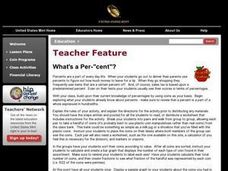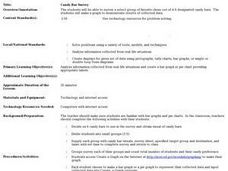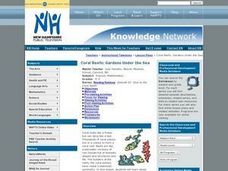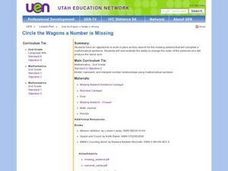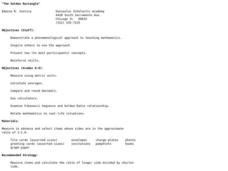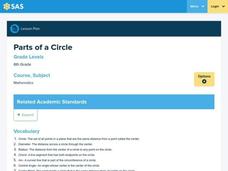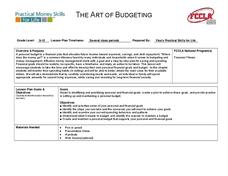Curated OER
Introducing Trig
Fifth graders explore the importance of triangles in the real world. They find the unknown side of a right triangle using a scale drawing. Students use Pythagoras' Theorem and other appropriate ratios.
Curated OER
What's a Per-"cent"?
Students recognize the mathematical connections between fractions and percents. They develop and study graphs to make connections between their data and what it represents. They write about the connections they have discovered.
Curated OER
Similarity
Students engage in a lesson that is concerned with the concept of similarity. This takes higher order thinking skills and being able to separate into categories. Specifically in this lesson they are introduced to the scale and how it is...
Curated OER
Candy Bar Survey
Second graders investigate the skill of graphing data by using candy bars to create context for the lesson. They use technology for graphing and organizing information like a spreadsheet. The lesson includes a resource link to aid in the...
Curated OER
Coral Reefs: Gardens Under the Sea
Students discover the wonders of coral reefs while listening to a book about them. In a Reading Rainbow video activity, they simulate a dive, check equipment and explore a reef. Role-playing as marine biologists, students uncover...
Curated OER
Circle the Wagons a Number is Missing
Second graders have an opportunity to work in pairs as they search for the missing addend to complete a mathematical sentence. They identify and demonstrate the ability to change the order of the addends and still produce the same sum....
Curated OER
Composite Functions
Students create a poster to explain composite functions. In this composite function worksheet, students explore linear equations and functions. They complete a worksheet and use manipulatives to complete problems.
Curated OER
Area Explorations
Young scholars explore the concept of area. In this area lesson, students find the area of irregular shapes with right angles. Young scholars break down each irregular shape into multiple regular shapes in order to find the area. ...
Curated OER
The Golden Rectangle
Students explore the concept of the golden ratio. For this golden ratio lesson, students measure objects to determine if their measurements fit the golden ratio. Students calculate the average measurements of the class.
Curated OER
How to Reason
Young scholars practice their logical thinking skills. In this reasoning lesson, students complete tasks involving geometric shapes, place value, and odd/even numbers.
Curated OER
57 Varieties of Interdependence
Students examine the life of Henry J. Heinz and how he began his career in food service. For this economic history lesson plan,students study how Henry J. Heinz started his business. Students will create and answer key questions that...
Curated OER
Parts of a Circle
Sixth graders use yarn, paper plate, and other materials to identify parts of a circle. In this parts of a circle lesson plan, 6th graders identify the circumference, radius, diameter, and other parts of a circle.
Curated OER
Cut, Construct and Think
Learners complete geometrical shapes construction activities. For this geometrical concepts lesson, students cut shapes from a worksheet to create a geometrical study activity. Learners analyze their shapes and complete a table. Students...
Curated OER
The Art of Budgeting
Students create a plan to achieve personal and financial goals. In this budgeting goals lesson, students identify their sources of income and discuss being financially independent. Students record their monthly expenditures and present a...
Curated OER
Pounds and Ounces: It's All About Weight
First graders explore number sense by participating in a measurement estimation activity. In this weight lesson, 1st graders discuss the differences between measurement units, both English and Metric. Students examine a loaf of bread to...
Curated OER
Let's Go Golfing
Students bring their visions for golf courses to life. In this scale model lesson, students research golf courses online, plan golf courses on grid paper, and then create scale models of the courses they planned.



